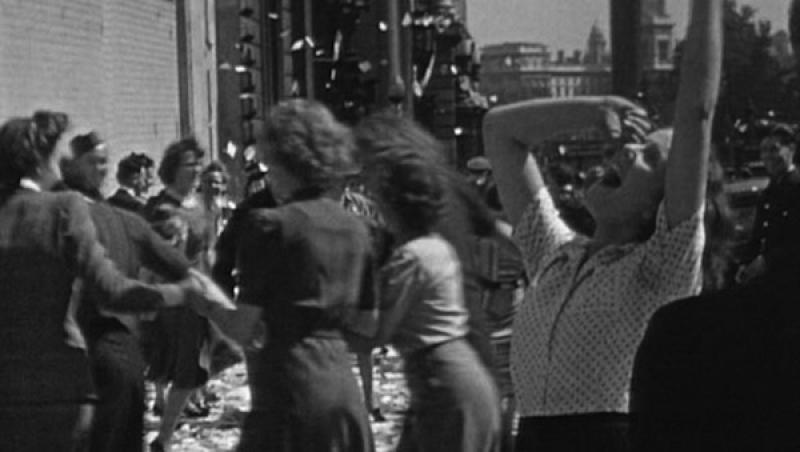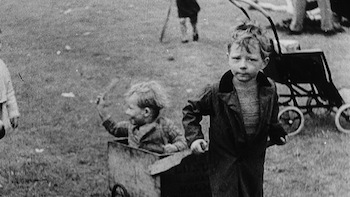The Spirit of '45 | reviews, news & interviews
The Spirit of '45
The Spirit of '45
Ken Loach's documentary celebrates the achievements of Clement Attlee's post-war Labour government

Ken Loach’s first solo documentary since The Flickering Flame, The Spirit of ‘45 is an indispensable agitprop movie that might have been subtitled Days of Hope, after Loach and Jim Allen’s 1975 drama serial about the political struggle of a socialist family between the Great War and the General Strike.
Constructed from archival footage and on-camera oral reminiscences of socialist frontliners now in their eighties and nineties, the new film captures the halcyon moment in post-war British history when equitability – “common ownership” – seemed as valid a prospect as that of jobs, medical attention, and good housing becoming available to all. After describing the despair of the 1930s, when the free market economy benefited only the elite, and touching on the Blitz and V.E. day, the film celebrates Labour’s 1945 landslide victory, Clement Attlee taking power with the party’s first electoral majority. Miners weeping with joy is one of the more vivid images recalled by a witness.
In depicting the run-up to the election, Loach pointedly cuts in footage of Winston Churchill, the late coalition leader and Conservative candidate, looking confused as he’s heckled by a crowd; alarmed by his reading of Friedrich Hayek’s The Road to Serfdom, Britain’s war hero had squandered much of his popularity by making the alarmist assertion that a “socialist system…would have to fall back on some form of Gestapo.”
The creation of the Welfare State and Aneurin Bevan’s nationalising of health care, utilities, transportation, the mining and docking industries, as well as the expansion of council housing, were received as practical manna by the ageing survivors of the inter-war slump, the returning combatants, and the home-front workers. The aim of these sweeping measures was to protect the working-class majority from unemployment and its concomitants: poverty (below), squalor, and illness.
 The film logs the successive acts of nationalisation without triumphalism, but offers few statistics (less, for example, than did Loach’s groundbreaking 1966 housing docudrama Cathy Come Home). It’s enough that we learn some people got specs and dentures for the first time after the National Health Service Act was passed.
The film logs the successive acts of nationalisation without triumphalism, but offers few statistics (less, for example, than did Loach’s groundbreaking 1966 housing docudrama Cathy Come Home). It’s enough that we learn some people got specs and dentures for the first time after the National Health Service Act was passed.
About three-quarters in, Loach ends this section of the film with footage of the summer 1951 Festival of Britain. That October, Churchill returned to power: the Tories were elected with a 17-seat majority despite losing the popular vote. However, after acknowledging Labour’s achievement of full employment and a functioning national health service under Attlee, Loach cuts abruptly to the Thatcher government’s policy of aggressive privatization, which dismantled the very idea of public ownership (limp on though the NHS does). The concertina structure of the movie makes dramatic sense, but the absence of analysis of the nationalization of 10 British industries between 1967 and 1977 leaves questions unanswered about cross-party attitudes during the Wilson, Heath, and Callaghan governments.
The Spirit of ‘45 is saved from dryness by the storytelling of the interviewees – 90-year-old Eileen Thompson’s memories of accompanying her union-organizer dad to the Liverpool docks with his orange box; 88-year-old Sam Watts’s recollection of sleeping in a vermin-infested bed with his siblings in a Liverpool house of death in the ’20s and ’30s. He was politicized in his mid-twenties, he says, by the first book he ever read – Robert Tressel’s The Ragged-Trousered Philanthropists.
Loach’s off-camera interviewing is discreet; one of his interviewees calls him “Ken” but we neither see nor hear him. His evocative calibrating of the footage – which concludes with a spectacular color rendering of the VE Day image that started the film – makes one wish there was more to come. Free marketeers and anyone else on the right who sees The Spirit of ‘45 will loathe it, neglecting as usual that, like Loach’s fictional films, its political agenda is driven by his compassion for ordinary people and his belief in their right to be treated fairly, share in the common wealth, and have jobs, medicine, and decent houses.
Watch the trailer for The Spirit of '45
rating
Explore topics
Share this article
The future of Arts Journalism
You can stop theartsdesk.com closing!
We urgently need financing to survive. Our fundraising drive has thus far raised £49,000 but we need to reach £100,000 or we will be forced to close. Please contribute here: https://gofund.me/c3f6033d
And if you can forward this information to anyone who might assist, we’d be grateful.

Subscribe to theartsdesk.com
Thank you for continuing to read our work on theartsdesk.com. For unlimited access to every article in its entirety, including our archive of more than 15,000 pieces, we're asking for £5 per month or £40 per year. We feel it's a very good deal, and hope you do too.
To take a subscription now simply click here.
And if you're looking for that extra gift for a friend or family member, why not treat them to a theartsdesk.com gift subscription?
more Film
 Can I get a Witness? review - time to die before you get old
Ann Marie Fleming directs Sandra Oh in dystopian fantasy that fails to ignite
Can I get a Witness? review - time to die before you get old
Ann Marie Fleming directs Sandra Oh in dystopian fantasy that fails to ignite
 Happyend review - the kids are never alright
In this futuristic blackboard jungle everything is a bit too manicured
Happyend review - the kids are never alright
In this futuristic blackboard jungle everything is a bit too manicured
 Robert Redford (1936-2025)
The star was more admired within the screen trade than by the critics
Robert Redford (1936-2025)
The star was more admired within the screen trade than by the critics
 Blu-ray: The Sons of Great Bear
DEFA's first 'Red Western': a revisionist take on colonial expansion
Blu-ray: The Sons of Great Bear
DEFA's first 'Red Western': a revisionist take on colonial expansion
 Spinal Tap II: The End Continues review - comedy rock band fails to revive past glories
Belated satirical sequel runs out of gas
Spinal Tap II: The End Continues review - comedy rock band fails to revive past glories
Belated satirical sequel runs out of gas
 Downton Abbey: The Grand Finale review - an attemptedly elegiac final chapter haunted by its past
Noel Coward is a welcome visitor to the insular world of the hit series
Downton Abbey: The Grand Finale review - an attemptedly elegiac final chapter haunted by its past
Noel Coward is a welcome visitor to the insular world of the hit series
 Islands review - sunshine noir serves an ace
Sam Riley is the holiday resort tennis pro in over his head
Islands review - sunshine noir serves an ace
Sam Riley is the holiday resort tennis pro in over his head
 theartsdesk Q&A: actor Sam Riley on playing a washed-up loner in the thriller 'Islands'
The actor discusses his love of self-destructive characters and the problem with fame
theartsdesk Q&A: actor Sam Riley on playing a washed-up loner in the thriller 'Islands'
The actor discusses his love of self-destructive characters and the problem with fame
 Honey Don’t! review - film noir in the bright sun
A Coen brother with a blood-simple gumshoe caper
Honey Don’t! review - film noir in the bright sun
A Coen brother with a blood-simple gumshoe caper
 The Courageous review - Ophélia Kolb excels as a single mother on the edge
Jasmin Gordon's directorial debut features strong performances but leaves too much unexplained
The Courageous review - Ophélia Kolb excels as a single mother on the edge
Jasmin Gordon's directorial debut features strong performances but leaves too much unexplained
 Blu-ray: The Graduate
Post #MeToo, can Mike Nichols' second feature still lay claim to Classic Film status?
Blu-ray: The Graduate
Post #MeToo, can Mike Nichols' second feature still lay claim to Classic Film status?

Add comment